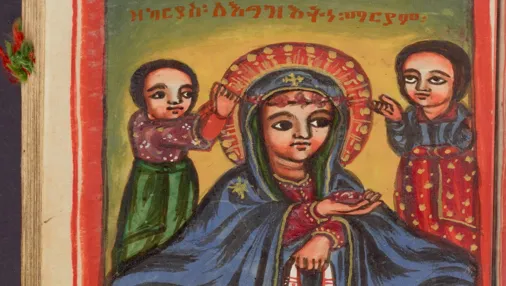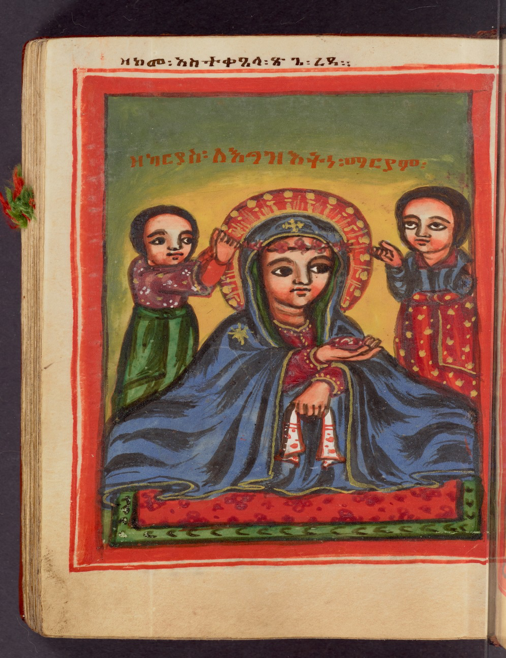Princeton Ethiopian Miracles of Mary Project Receives CDH Research Partnership Grant
4 June 2019

Stories have been told for almost two millennia about the Virgin Mary and the miracles she has performed for the faithful who call upon her name. One of the most important collections of such folktales is the body of almost 700 Ethiopian Marian miracles, written from the 1300s through the 1900s, in the ancient African language of Gəˁəz (also known as classical Ethiopic). These tales, called the Täˀammərä Maryam (The Miracles of Mary), are central to the daily life of 50 million Ethiopians and Eritreans and of special interest at Princeton University, which has in its Firestone Library one of the largest and finest collection of Ethiopic Manuscripts, and Marian miracle manuscripts, anywhere in the world outside of Ethiopia.
Wendy Laura Belcher, professor of African literature in the departments of Comparative Literature and African American Studies, has been studying the Täˀammərä Maryam for some time, ever since she and the Ethiopian priest and scholar Qesis Melaku Terefe catalogued many of the Princeton Gəˁəz manuscripts over the summer of 2009. At her request, in spring 2018, the Library began digitizing its Gəˁəz manuscripts; prioritizing the Täˀammərä Maryam, which are now all digitized and online in Digital PUL. This is causing a surge of global interest, as well as demand for better data about them.

A young man crowning the icon of the Virgin Mary with roses.
From Princeton Ethiopic Manuscript No. 57,
Täˀammərä Maryam (Miracles of Mary), folio 54b.
From the Manuscripts Division, Department of
Rare Books and Special Collections, Princeton University
Library. View all images in this manuscript.
Belcher is now designing a database that will collect and collate information about these hundreds of tales across hundreds of manuscripts. As the principal investigator of the Princeton Ethiopian Miracles of Mary (PEMM) project, Belcher aims to create a resource that will allow researchers around the world to explore the ways that these African tales evolved across regions, languages, and periods.
Belcher’s initial work on the digital project was supported during the 2018-19 academic year by Dataset Curation and Public Humanities Grants from the CDH. In the coming academic year, the PEMM’s next phase will be supported by our new Research Partnership Grant. Primary support for this project comes from a “Global Initiative” grant from the Humanities Council at Princeton University, supported by the David A. Gardner ‘69 fund for innovation in the humanities. The CDH Development and Design Team will work with Belcher to create a robust data structure to store and connect the data, and will collaborate on building the project’s preliminary web interface and several data visualizations.
In the year to come, Prof. Belcher and a team of graduate and undergraduate research assistants will catalog and enter data about this vital corpus of African folktales, enabling computational analysis on their dating, origin, provenance, themes, recensions, translations, sources, placement, and diachronic change. They will clean, correlate, transcribe, translate, document, and make accessible a range of information about this corpus of texts. One challenge is that the data will use Latin letters with many diacritics (about 20 Unicode characters, like ə, ṭ, ṣ, ś, ä, ə, w, ḍ, ǧ, ḥ, ḫ, ḵ, č, ñ), as well as over 300 Ethiopic fidəl characters (also available in Unicode, like ወ፣ቀ፣ም፣ት).
The Täˀammərä Maryam is one of the most important African archives of texts and yet such basic information is lacking; as a result, scholars can authoritatively state almost nothing about it. These stories are central not only to the ancient church liturgy of Ethiopia, but to the daily felt and religious life of millions in Ethiopia and the diaspora. Once completed, the PEMM database will be open access and, if possible, designed in a format that allows for community contributions and crowd-sourced translations. In addition to scholars, members of the Ethiopian community around the world will be able to participate in constructing this database of an essential part of the Ethiopian patrimony.